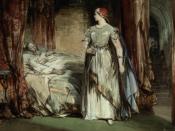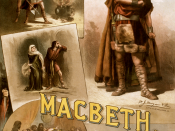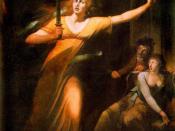Evil and Gender Archtypes in Macbeth
At the heart of William Shakespeare's Macbeth is an examination
of the nature of evil and it's many faces and facets. The principal evil characters in the
play, Macbeth and Lady Macbeth, are both evil, but the manifestation of evil is different
in each.
Macbeth's evil is a dynamic character trait. He begins the play as a celebrated
hero, loyal to his friends and dedicated to his king. He is strong and noble, a man to be
admired by his audience. Then he and Banquo are visited by the three witches, who
promise him that he will be king. This veiled initmation ignites a secret ambition within
Macbeth. Evil has dawned within him, but at this early stage of his transformation
Macbeth is ashamed of his evil urges. He says, 'Stars, hide your fires;/ Let not light see
my black and deep desires;/ The eye wink at the hand; yet let that be,/ Which the eye
fears, when it is done, to see.'
(I, iv, 50) Soon, however, Macbeth is overcome by his
ambition and his fall begins. He says, 'I have no spur to prick the sides of my intent, but
only/ Vaulting ambition, which o'erleaps itself/ and falls on the other.' (I, vii, 25) As
soon as the descision to murder Duncan is made, and until his death, Macbeth is a vessel
relentlessly filling with evil. Macbeth is the source of all the dastardly deeds in this play.
The witches ignite his evil ambition, Lady Macbeth stokes the fire, but the blame for
Duncan's murder rests squarely on the shoulders of Macbeth. Macbeth may not have
held the knives that killed Banquo or Macduff's family, but the agression is his.
Lady Macbeth does not descend into evil. She wallows in it.


